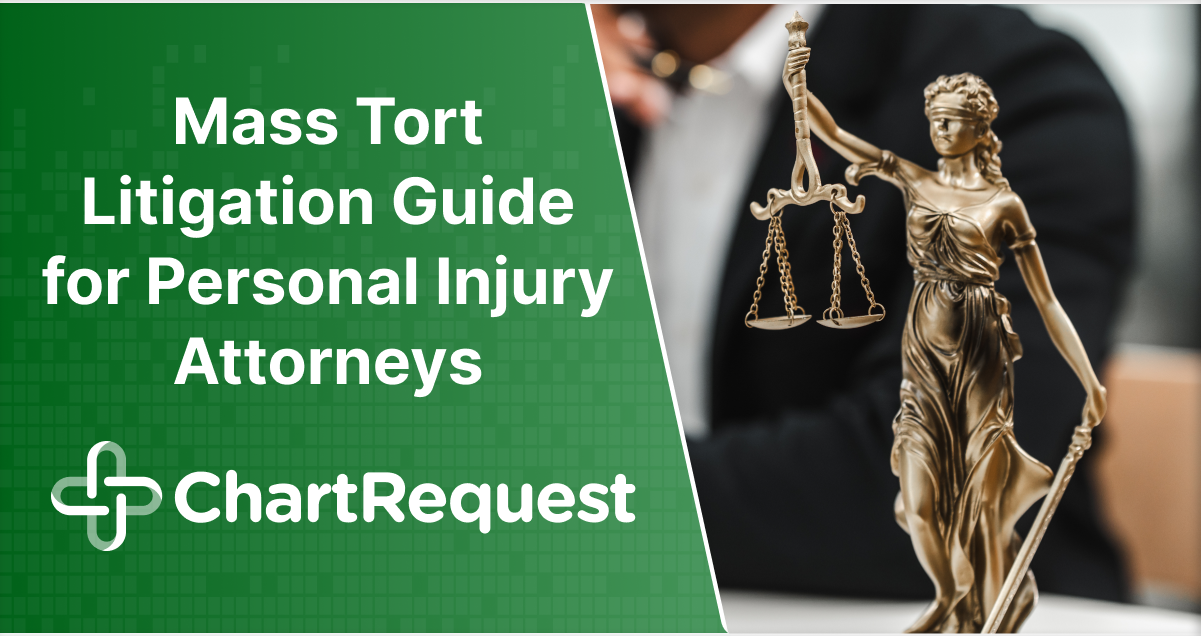Mass tort litigation can be a practical way to pursue compensation for numerous personal injury and medical malpractice claimants. However, the process can be lengthy for all parties involved — as demonstrated by Anderson v. Cryovac, Inc.: a case that lasted nearly a decade.
In this article, we’ll discuss the importance of mass torts when representing victims of widespread harm. Review the information, then contact us to learn more about how much time your law firm can save during the discovery process.
What Is Mass Tort Litigation?
A mass tort is a legal action in which multiple victims sue one or several defendants in civil court for similar injuries. Attorneys often resolve mass tort cases through multidistrict litigation (MDL) — connecting shared injuries to harmful business practices and products. Mass tort procedures centralize the litigation process and free up court resources.
Before 2013, multidistrict litigation could typically accommodate dozens of claimants at a time. Involved parties would appear before the same court under the same judge. With recent improvements in case-building technology, communication, and patient-attorney coordination, it’s common to see MDLs with thousands of claimants.
As you may expect, initiating and navigating mass tort litigation around many parties can be exhausting for small to medium law firms. Taking the time to develop your legal strategy can improve your likelihood of success during settlements and trials.
Types of Mass Tort Litigation Cases
Mass torts often occur from negligence in the workplace, healthcare settings, and other sectors where people may be at risk of injury. Each case is unique, but common mass tort cases address:
- Pharmaceutical and Medical Devices: The improper application of drugs or medical equipment may harm patients during treatment. For example, a report by the Food and Drug Administration linked 80,000 medical deaths related to stimulators since 2008.
- Environmental: This mass tort scenario involves injuries caused by pollution or toxic substances. Take, for example, the Flint water crisis, which exposed thousands of Michigan residents to lead in their drinking water.
- Financial Misconduct: A company’s negligence may cause significant financial harm to many people. For instance, a banking automation error may wrongly charge fees to millions of customers.
- Data Breach and Privacy Violations: It is vital for businesses and healthcare organizations to protect their digital data. Network breaches that expose personal and financial information may trigger a mass tort case, as in the case of Equifax. The company paid victims $425 million after accidentally disclosing personal data.
Mass Tort vs. Class Action | Understanding Key Differences
Mass torts may appear similar to class action lawsuits but have differing characteristics.
Understanding the difference between mass tort and class actions can help you better prepare your case:
- Case Volume: Class action lawsuits involve thousands or even millions of people represented in a single civil case (see Careathers vs. Red Bull). Mass torts may include thousands of claimants, but the court considers each case separately.
- Similarity of Claims: In class actions, all parties file similar claims against the same defendant. Mass torts may represent varied claims (such as the nature of the injuries sustained) and may include more than one defendant.
- Representation: A single law firm represents everyone in a class action. In mass torts, each plaintiff can bring in their own lawyer.
- Settlement and Compensation: In class actions, the court splits equal compensation among victims. In contrast, mass torts may reimburse victims proportionally to their specific injuries.
- Timeframe: Class actions usually set a deadline for involved parties to participate. On the other hand, mass torts allow claimants to join an ongoing case with few initial time limitations.
How Does Mass Tort Litigation Work?
Mass tort is a complex legal process that involves multiple steps. Properly following each step of litigation will increase your client’s chances of earning a better settlement.
1. Filing a Lawsuit
Suppose a client approaches you with a credible case against a wrongful party. After careful consideration and research, you discover that filing a mass tort case may be the most appropriate action for your client to pursue compensation.
During this initial step, it’s crucial to identify additional victims involved and the commonality of harm experienced by each party. Additionally, you must determine which defendant(s) are liable for damages.
Your due diligence is vital at this stage. Aside from networking with other lawyers, you may need to comb through hundreds of pages of medical records to gather evidence.

2. Consolidation
For judicial efficiency, mass tort cases often transfer to a single court for ruling. This consolidation may occur at a state level or through a federal MDL. An MDL allows all related cases to undergo pre-trial proceedings, such as discovery and motions, under one judge.
Consolidation helps streamline the process and reduce conflicting rulings. Combining cases can also give plaintiffs a stronger negotiating position against large corporations or entities.
3. Bellwether Trials
MDLs may select individual cases in a mass tort for bellwether trials. These early trials will help you gauge how future cases might unfold regarding jury reactions and settlements. Bellwether trials can result in settlement negotiations for the remaining cases.
4. Settlements or Trials
Involved parties will settle based on the evidence gathered during the MDL proceedings and the outcomes of corresponding bellwether trials. Courts will finalize rulings en masse or send them back to their original jurisdiction if they cannot reach a decision.
Remember, settlements in mass tort cases can differ from plaintiff to plaintiff, depending on the damages they suffer.
Common Challenges You May Face During Mass Tort Litigation
Despite being a tool for justice, the road to a successful settlement is rarely smooth for mass tort litigations. Here are some of the common issues you may encounter along the way:
Complex Cases
Individuals involved in mass tort cases often experience varying degrees and types of harm. These nuances make it challenging to assess and quantify damages uniformly. Litigation involving physical injuries requires your legal team to review dozens — if not thousands — of medical records to develop a compelling case.
Without the proper staffing and resources, your law firm may struggle to meet court deadlines during just the investigative phase. Investing in a trusted record retrieval platform like CaseBinder will ensure you have speedy access to the resources you need to address the court.
Costly Initiatives
When handling mass tort cases, you will have to invest significant finances, time, and personnel resources. The cost of expert witnesses, research, and gathering evidence can be substantial.
Mass tort financing has become popular for attorneys seeking to sustain their initiatives. This solution may help you and your team avoid unnecessary losses and cover the expenses of pursuing a case.
Jurisdictional Issues
As mentioned, mass torts involve multiple plaintiffs, defendants, and jurisdictions. It’s common to see cases filed in federal and state courts simultaneously, which can create confusion over which court should oversee litigation.
5 Best Practices When Handling Mass Tort Litigation Cases
Mass tort litigations are high stakes for both you and your clients. High returns go hand in hand with high losses should your case not pan out. Following best practices can help you achieve favorable outcomes for your clients:
Here are the best practices to follow during your next mass tort:
1. Build a Strong Team
Your team should have the knowledge and experience to handle complex cases like mass torts. Working with the right paralegals, researchers, and partnering attorneys will save you time and resources throughout the proceedings.
2. Embrace Modern Technology
Managing records for multiple plaintiffs and defendants is daunting. Embrace modern ROI platforms to minimize your workload and reduce costs. These resources can guarantee HIPAA compliance while exchanging medical information and eliminate the risk of accidental data leaks.
3. Negotiation Strategy
Always prepare yourself for lengthy settlement negotiations during a mass tort. Identify critical issues in the case and develop a negotiation strategy to give you an upper hand. Keeping your client informed throughout the process is essential, especially when handling their sensitive health information.
4. Expert Witnesses
Enlist the help of expert witnesses to strengthen your case. Expert witnesses can provide important insight and testimony in complex areas such as medical and scientific evidence. These individuals may be able to verify and reinforce the evidence presented in patient medical reports.
5. Stay Organized
Mass tort cases involve sifting through large amounts of data, records, and documents. Staying organized with a centralized record platform is the best way to build your case without hassle.
ChartRequest Can Help You Build Stronger Mass Tort Cases
Mass tort litigation is pivotal in helping victims pursue their desired compensation after an injury or wrongful death. Don’t let delays in medical record retrieval delay your process.
ChartRequest helps you retrieve medical records efficiently and securely, allowing you to focus on building a stronger case for your clients. With our user-friendly platform, your team can quickly request, track, and receive medical records from multiple providers in one place.
Create Your RecordGateway Account to Get Started!
Moreover, you can free up your paralegals by partnering with us to do the heavy lifting and record vendor communication on your behalf. Schedule a brief consultation to learn more about our Full-Service solution for law firms.


